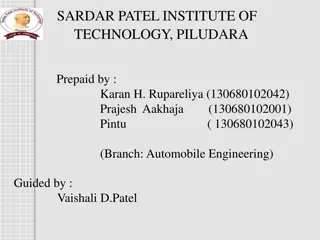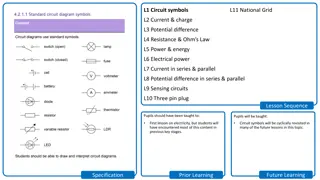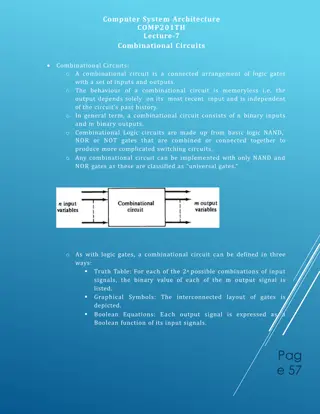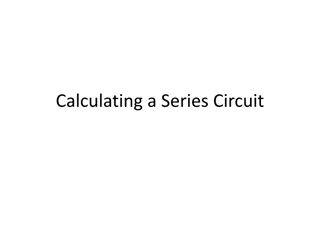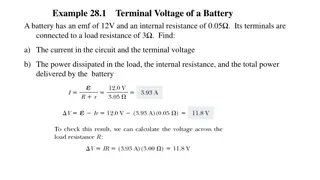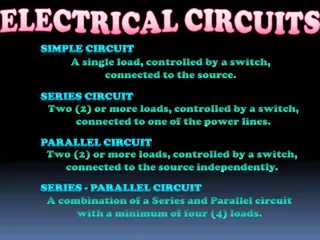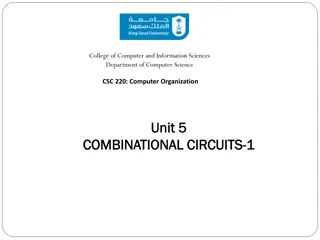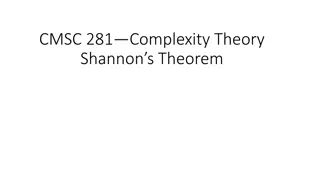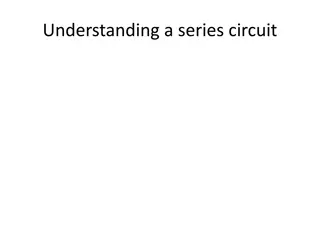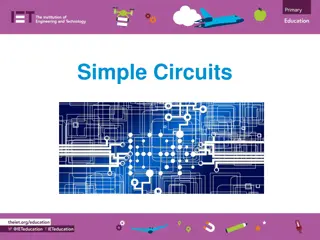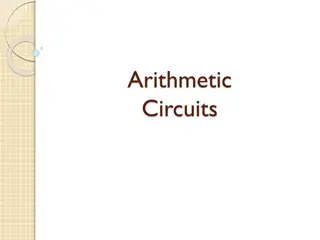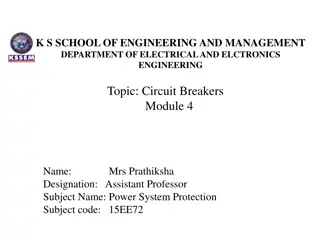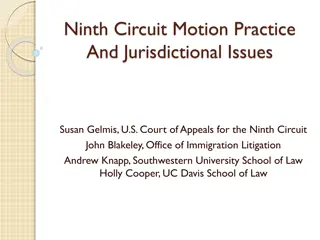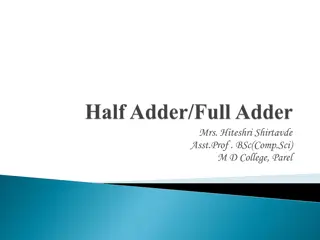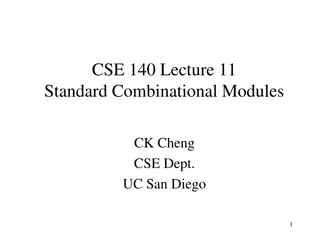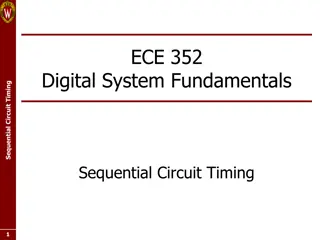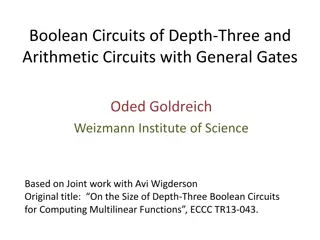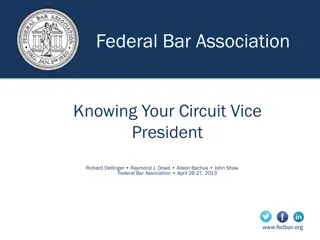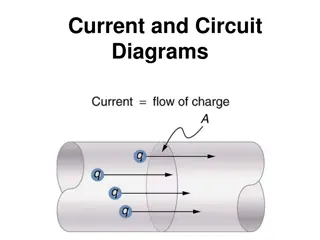Designing a 5V DC Power Supply Using IC 7805: Step-by-Step Guide
Design a 5V DC power supply using IC 7805 by selecting a regulator IC, transformer, diodes for the bridge, smoothing capacitor, and ensuring safety. The circuit includes an input transformer, rectifier circuit, filter, and regulator. Understand the importance of each component in the design process
5 views • 20 slides
Understanding Sequential Circuits: A Brief Overview
Sequential circuits differ from combinational circuits in that the output depends not just on the current input but also on the circuit's past history. This overview covers the basics of sequential circuits, including finite-state automata, states, transitions, and memory elements like flip-flops.
2 views • 50 slides
Power System Fault Calculation and Protection Analysis
In this technical document, we delve into the calculation of fault current and fault apparent power in symmetrical three-phase short circuit scenarios within power systems. Through detailed equivalent circuit diagrams, reactance calculations, and per unit value derivations, the fault current and app
5 views • 15 slides
Understanding Sequential Logic Circuits in Digital Systems
Logic circuits in digital systems can be either combinational or sequential. Sequential circuits utilize storage elements along with logic gates, where outputs depend not only on present inputs but also on past inputs and internal states. They are essential building blocks, with storage registers pl
5 views • 20 slides
Adventurous 8-Day Spiti Circuit Biking Journey
Embark on an exhilarating Spiti circuit biking trip from Delhi! Join WanderOn's Spiti Valley Biking Expedition for 2024 and immerse yourself in the ultimate riding experience through stunning landscapes. To learn more , visit https:\/\/wanderon.in\/trip\/spiti-circuit-biking
4 views • 1 slides
Circuit Training Methods: A Comprehensive Guide
Circuit training is a versatile workout method that combines various exercises to target strength, endurance, and overall fitness. Developed in 1953, it offers a time-efficient way to enhance multiple fitness components simultaneously. This article explores popular circuit training methods, advantag
2 views • 24 slides
Inside the Circuitry of the Casio CTK-450 Electronic Keyboard
Detailed insights into the internal components of the Casio CTK-450 electronic keyboard, covering the power supply, CPU functionality, keyboard matrix circuit, filter block, and mute circuit. Explore how each element contributes to the overall functioning of the keyboard, from processing key presses
0 views • 11 slides
Understanding Miniature Circuit Breakers (MCB) in Automobile Engineering
Learn about Miniature Circuit Breakers (MCB) used in Automobile Engineering, including their principle of operation, construction, and application. MCBs serve as efficient replacements for traditional fuses, providing overload and short circuit protection through thermal and magnetic mechanisms. The
0 views • 15 slides
Understanding Combinational Circuits in Computer Architecture
Combinational circuits in computer architecture play a crucial role in transforming binary information from input data to output data. These circuits consist of logic gates connected in a specific arrangement to process binary data efficiently. Key components such as half-adders and full-adders are
1 views • 48 slides
Exploring the Impact of Salt Quantity on Saltwater Circuit Current
A saltwater circuit utilizes saltwater as a key element for conducting electricity. This unique circuit involves the dissolution of salt into sodium and chloride ions, which, when exposed to an electric voltage, allows for the flow of electricity. The quantity of salt present in the circuit directly
0 views • 9 slides
Understanding Electricity: Circuit Symbols and Components
Explore the fundamentals of electricity with a focus on circuit symbols, components, series, and parallel circuits. Delve into the difference between complete and incomplete circuits, and discover the importance of using circuit diagrams to depict electrical setups accurately.
0 views • 18 slides
Comprehensive Guide to Electric Circuits and Circuit Diagram Interpretation
Explore the fundamentals of electric circuits, circuit components, and diagram interpretation. Learn about series and parallel circuits, resistors, sources, switches, transducers, and more. Discover how to calculate resistance, current, and potential difference in circuits. Gain insights into diodes
2 views • 76 slides
Understanding Electrical Circuits: Basics and Types
The presentation covers the basics of electrical circuits, explaining the concept of electric current, the role of cells and batteries, simple circuit components like switches and lamps, and circuit diagrams. It further delves into types of circuits - series circuits and parallel circuits, detailing
0 views • 24 slides
Understanding Combinational Circuits in Digital Systems
Combinational circuits in digital systems consist of logic gates interconnected to process input signals and produce output based solely on the current input, without any memory. They are implemented using basic logic gates like NAND, NOR, or NOT gates, which can be combined to create complex switch
0 views • 5 slides
Understanding Series Circuit Calculations for Voltage, Current, and Power
Exploring the calculations in a series circuit to determine voltage, current, power, and total resistance. Learn the formulas and steps to find these values, emphasizing the relationship between resistance, current, and voltage drops in the circuit.
0 views • 12 slides
Preparing for Oral Argument in the Eleventh Circuit: Essential Tips
Understand the process of oral arguments in the Eleventh Circuit, including when to request oral argument, FRAP 34 guidelines, and how to handle the notice of oral argument. Get insights on making the most of oral argument opportunities and potentially shaping circuit law.
0 views • 32 slides
Electrical Circuit Analysis Examples and Solutions
Explore various examples of electrical circuit analysis involving batteries, resistors, and parallel connections. Learn how to calculate current, voltage, power dissipation, and equivalent resistance in different circuit configurations. Detailed solutions provided for better understanding.
0 views • 12 slides
Software Engineering Design Principles and Concepts
The chapter discusses the essential principles and concepts in software design, highlighting the four key design models - data design, architectural design, interface design, and component-level design. It emphasizes the importance of traceability to the analysis model, minimizing the gap between so
0 views • 36 slides
Understanding Electrical Circuits: Basics and Wiring Diagrams
Explore different types of electrical circuits including simple circuit, series circuit, parallel circuit, and combination circuits. Learn about loads, switches, and connections to power sources. Dive into wiring diagrams for practical applications and visual understanding.
0 views • 8 slides
Understanding Combinational Circuits in Computer Science
Explore the fundamentals of combinational circuits in computer science, including adders, subtractors, half adders, and full adders. Learn about circuit design, optimization, and manipulation of equations to enhance computational efficiency.
0 views • 25 slides
Transistor Tuned Amplifiers: Operation and Analysis
Transistor tuned amplifiers consist of a parallel tuned circuit as the collector load, amplifying a specific frequency while rejecting others. The resonant frequency of the tuned circuit is crucial for amplification. A high Q circuit offers maximum voltage gain at the resonant frequency but decrease
0 views • 30 slides
Understanding Electronic Components in Circuits
An electrical circuit converts energy while an electronic circuit processes information. Electronic components like buzzer, diode, LED, and LDR play essential roles in circuit operations. Learn about the functions and symbols of these components, including forward and reverse bias in diodes.
1 views • 14 slides
Exploring Circuit Size Bounds in Complexity Theory
The article delves into Shannon's Theorem in Complexity Theory, discussing the upper bounds of circuit sizes for Boolean functions of n variables. It explores the 1-1 correspondence with 0-1 strings of length 2n and how Boolean functions can be expressed as CNF or DNF formulas. The computation of th
2 views • 19 slides
Verilog FF Circuit Examples & Assignments Overview
Delve into Verilog FF circuit examples such as Gated D Latch and D Flip-Flop. Understand blocking and non-blocking assignments, their differences, and practical implications. Learn when to use each assignment method in Verilog design for combinational always blocks.
0 views • 17 slides
Understanding a Series Circuit: Exploring Potential Difference, Current, and Resistance
Dive into the concept of a series circuit by visualizing it as a circular road with cars representing electrical charge flow. Learn about potential difference, current, energy transfer, and resistance in the circuit through relatable analogies and illustrations. Understand how a break in the loop or
0 views • 48 slides
Creating a Simple Circuit with Motor, Battery, and Switch
This guide illustrates how to assemble a simple electrical circuit using a motor, battery pack, switch, wires, and a homemade paper clip switch. Learn the steps involved in preparing and joining wires, making a switch from a paper clip, and assembling the components to complete the circuit. Follow a
0 views • 7 slides
Intelligent Battery Charger Circuit Design Overview
This presentation outlines the design requirements, challenges faced, and solutions implemented in the development of an intelligent battery charger. The initial design utilized separate circuits for different battery types, leading to complexity and limited control. The final design incorporated a
0 views • 26 slides
Understanding Combinational Circuits in Computer Architecture
A combinational circuit consists of logic gates that transform binary input data into output data based on the input combination. This chapter covers the design and functionality of half-adders and full-adders, essential components in digital systems. Through truth tables, Boolean functions, and log
0 views • 15 slides
Understanding Combinational Circuits in Digital Electronics
Combinational circuits are an essential component of digital electronics, combining different gates to perform specific functions without memory usage. They provide outputs based solely on present input levels, with no influence from previous states. Types of combinational circuits include half adde
0 views • 55 slides
Advanced Circuit Simulation Using Matrix Exponential Operators
Explore the innovative approach of circuit simulation via matrix exponential operators as proposed by CK Cheng from UC San Diego. The method involves utilizing general matrix exponentials, Krylov spaces, Arnoldi orthonormalization, and inverting Krylov subspaces for accurate simulations. These techn
0 views • 28 slides
Comprehensive Overview of Circuit Breakers in Power System Protection
Circuit breakers play a critical role in protecting electrical circuits from damage caused by excess current. This informative module covers topics like fault clearing time, arc voltage, arc interruption methods, and types of circuit breakers. Through detailed explanations and images, readers can un
0 views • 20 slides
Ninth Circuit Motion Practice and Jurisdictional Issues Summary
This text provides valuable information on Ninth Circuit motion practice and jurisdictional issues, focusing on topics such as petitions for review, tips for petitioning for review, motion for stay of removal, and related legal standards and procedures. It emphasizes the importance of timely filing,
0 views • 31 slides
Understanding Half Adders and Full Adders in Combinational Logic Circuits
Half adders and full adders are essential components in combinational logic circuits for performing addition operations on binary numbers. While half adders can add two single-bit numbers but do not consider carry bits, full adders can handle three bits with carry input. Understanding the input and
0 views • 9 slides
Understanding Standard Combinational Modules in Digital Design
Introduction to standard combinational modules such as decoders, encoders, multiplexers (Mux), demultiplexers (DeMux), shifters, adders, and multipliers. Exploring their behaviors, logic, and applications in signal transport, data processing, and address manipulation. Detailed explanation of how dec
0 views • 26 slides
Design of Multi-Level Gate Circuits Using NAND and NOR Gates
Explore the design and analysis of multi-level gate circuits using NAND and NOR gates, including two-level and multiple-output circuit design. Learn about circuit conversion, alternative gate symbols, AND-OR, OR-AND configurations, and factorization of multi-level gate circuits. Dive into examples a
0 views • 28 slides
Understanding Standard Combinational Modules in Digital Design
Delve into the realm of standard combinational modules with a focus on decoders, encoders, multiplexers, demultiplexers, and other essential components. Explore their behavior, logic, and applications in signal transportation, addressing, data manipulation, and processing within digital systems. Gai
0 views • 26 slides
Understanding Sequential Circuit Timing and Clock Frequency
Sequential circuit timing is crucial for designing digital systems. The minimum clock period, slack values, clock frequency, and critical paths play key roles in determining the operational speed and performance of sequential circuits. By analyzing flip-flop timing parameters, combinatorial logic de
0 views • 20 slides
Depth-Three Boolean Circuits and Arithmetic Circuits: A Study on Circuit Complexity
Explore the intricacies of depth-three Boolean circuits and arithmetic circuits with general gates, focusing on the size, structure, and complexity measures. The research delves into the relationship between circuit depth, gate types, and multi-linear functions, offering insights into circuit models
0 views • 12 slides
Federal Bar Association Circuit Vice Presidents: Roles and Responsibilities
Circuit Vice Presidents play a vital role within the Federal Bar Association, serving as a crucial link between national leadership and chapter leaders. Elected for 2-year terms and responsible for staying in contact with chapters within their circuits, Circuit Vice Presidents have duties that inclu
0 views • 20 slides
Understanding Current and Circuit Diagrams
Current is the flow of electrical charge, measured in amperes. It flows from positively charged to negatively charged sources, while electrons flow in the opposite direction. Conductors allow charge to flow easily, while insulators do not. Circuit diagrams show how a circuit works, with a battery as
0 views • 16 slides







